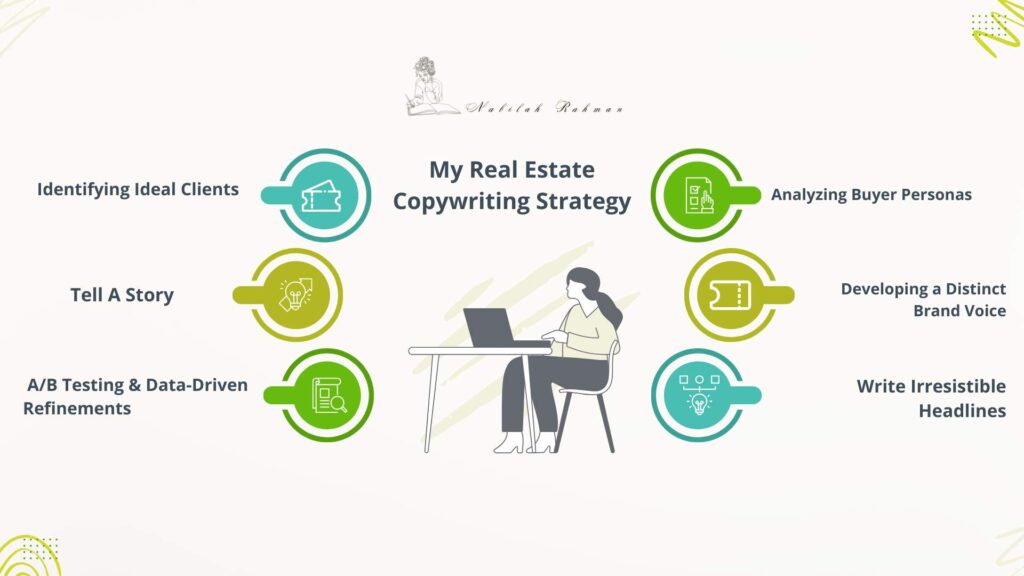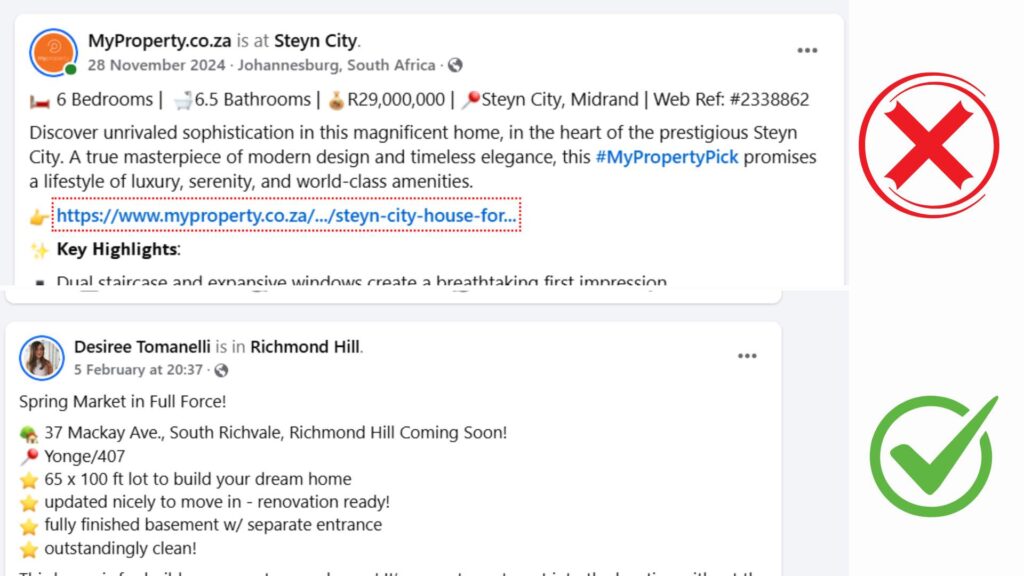Sarah, a new real estate agent, was searching for Professional copywriters and found me. She was frustrated. Her listings were stunning, but buyers weren’t biting. Website traffic was low, engagement was weaker, and inquiries? Barely trickling in.
The problem?
Her copy wasn’t selling the dream, just the details. Buyers scrolled past, uninterested.
But it can be fixed,
With storytelling-driven listings, SEO-rich content, and conversion-focused messaging. I turned things around. In just 6 months, her traffic zoomed by 120%, listing views doubled, and buyer inquiries surged by 45%.
Here’s how I help her with my real estate copywriting skills 👇
Why Their Listings & Content Weren’t Converting?
The listing wasn’t converting cause she was selling homes, not the dream. Her real estate listings had all the right details—
- Square Footage
- Modern Upgrades
- Prime Locations.
But they lacked the emotional connection buyers crave. Instead of depicting life in these homes, the descriptions felt flat and transactional.
Here’s what was holding her back:
Generic, Fact-Based Copy – “3-bed, 2-bath with a spacious kitchen” wasn’t making buyers dream about their future in the home.
No SEO Optimization – Her website wasn’t ranking for high-intent keywords like “luxury homes in Florida” or “best family-friendly neighborhoods.”
Weak CTAs & Engagement – Listings ended with bland phrases like “Contact us for more info” instead of compelling calls to action that drive urgency.
Ineffective Email & Blog Content – Her emails weren’t nurturing leads, and her blog lacked value-driven content that positioned her as it should be in real estate industry.
The result?
Low engagement, fewer inquiries, and missed opportunities.
It was time for a complete content makeover that turned passive browsers into serious buyers.
My Real Estate Copywriting Strategy
Being a real estate copywriter is easy if you know you are not selling a home but dreams. I learned that the hard way and applied the trick in this project. And the result was mind-blowing.
Here is what I did.

Identifying Ideal Clients
Before I even touched her listings, I had to figure out who we were selling to. Too often, real estate agents try to market to “everyone,” but that only leads to watered-down messaging that resonates with no one.
I needed to get specific about whether I wanted to boost engagement and conversions.
The first step? Looking at her previous clients. I dug into her sales history to identify patterns—
- who was buying these homes?
- Were they young professionals looking for their first home?
- Upsizing families?
- Luxury buyers seeking exclusivity?
What I found was eye-opening. While Sarah thought her listings attracted a mix of buyers, the data told a different story:
Her strongest engagement came from high-income professionals in their 30s and 40s looking for modern, move-in-ready homes.
That meant our messaging needed to shift from broad, generic descriptions to high-end, lifestyle-driven copy emphasizing convenience, style, and smart home features.
Analyzing Buyer Personas
Once I had a clear idea of Sarah’s ideal buyers, I took it a step further—I mapped out detailed buyer personas. Why? Because selling a home isn’t just about listing features. It’s about understanding,
- Who’s Buying
- What They Care
- Market Trends
- What Drives Their Decisions?
So, I did this,
Breaking Down the Buyers
I categorized her audience into three main groups:
Group 1: Young Professionals (Ages 30-40)
They wanted move-in-ready homes with modern upgrades, smart technology, and home office spaces. They weren’t interested in fixer-uppers. Their main concerns? Location, convenience, and style.
Group 2: Growing Families (Ages 35-50)
Space was their priority. They looked for safe neighborhoods, great school districts, and homes with big yards. Their biggest fears? Outgrowing a house too quickly or dealing with major renovations.
Group 3: Luxury Buyers (Ages 40-60)
They wanted exclusivity. Think high-end finishes, privacy, and prestige. They weren’t searching for “a house”. They wanted a statement home. Their decision-making was driven more by lifestyle than budget.
Tapping Into Their Motivations & Pain Points
Once I identified these personas, I asked: What makes them say YES to a home? And what holds them back?
Young professionals wanted homes that fit their busy lifestyles, were low maintenance, stylish, and located near work hubs. Any mention of outdated designs or lengthy renovations?
Instant turnoff.
Families prioritized safety and community. If a home lacked a backyard or was in a noisy area, they’d move on quickly.
Luxury buyers didn’t just want “high-end”—they wanted a story. They were drawn to homes with unique histories, breathtaking views, or custom details that made them one of a kind.
Developing a Distinct Brand Voice
Once I mapped out the ideal buyers, I knew the next step was branding. Sarah wasn’t just another real estate agent. She had a unique way of helping potential clients find homes that truly fit their lifestyles.
But her online presence?
It didn’t reflect that at all.
I asked Sarah,
‘If your brand were a person, how would they speak? Would they be formal and authoritative? Friendly and approachable? Luxe and exclusive?’
Sarah’s strength was her ability to make the home-buying process exciting and effortless for her clients.
That meant her brand voice needed to be:
✔ Conversational – No stiff, corporate language. Her content needed to feel like a friend guiding buyers through their dream home search.
✔ Story-Driven – Instead of just list of features, we told stories that helped buyers picture themselves in the space.
✔ Confident & Clear – No fluff, no jargon—just compelling descriptions that made buyers take action.
I Knew I Need To Tell A Story
I’ve seen it happen too often—real estate listings that feel more like laundry lists of features than actual homes people can picture themselves living in.
Sarah’s listings were no different at first. They had all the right details—square footage, number of bedrooms, even upgrades. But they weren’t connecting with buyers.
That’s when I knew, I needed to tell a story.
Instead of just stating the facts, I started painting a picture. Buyers don’t just want to know there’s a backyard—they want to imagine Sunday barbecues with family.
They don’t just care about “natural light”. They want to envision morning coffee by the window, bathed in golden sunlight.
Write Irresistible Headlines
I knew that if Sarah’s listings would stand out, they needed headlines that made buyers stop and pay attention. In real estate, first impressions matter—and with so many listings competing for clicks, a boring headline meant being ignored.

Most real estate headlines sound the same:
❌ “Beautiful 3-Bedroom Home in Great Location”
❌ “Spacious Condo with Modern Upgrades”
But real estate content shouldn’t sound like that.
So, I started testing emotion-driven, benefit-focused headlines that made buyers want to learn more about writing Attention-Grabbing Headlines.
A headline that works for a luxury home isn’t the same one that will sell a starter home. So, I write compelling headline based on buyer psychology. So, as a Real estate copywriter, I do that.
For example,
A/B Testing & Data-Driven Refinements
I didn’t just guess what worked—I tested it. We ran A/B tests on different headline styles and tracked:
🔹 Which headlines got the most clicks
🔹 Which ones led to more inquiries
🔹 Which ones converted into actual home tours
The result? A 30% increase in listing engagement just by optimizing headlines.
Ready to Elevate Your Real Estate Listings?
Great real estate copy isn’t just about listing features. It’s about telling a story that sells. Whether you need high-converting property descriptions, compelling website content, or engaging social media copy, I can help you turn words into sales.
Let’s craft an irresistible real estate copy that gets results!
Are you also a struggling real estate professional? Then




